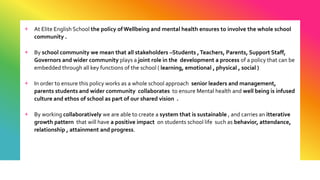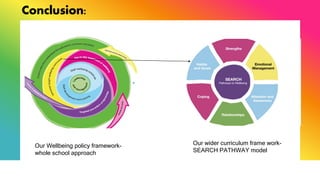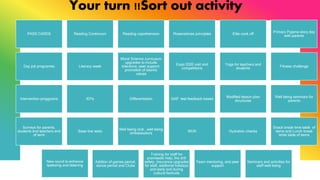Whole School Wellbeing policy .pptx
- 2. + At Elite English School the policy of Wellbeing and mental health ensures to involve the whole school community . + By school community we mean that all stakeholders –Students ,Teachers, Parents, Support Staff, Governors and wider community plays a joint role in the development a process of a policy that can be embedded through all key functions of the school ( learning, emotional , physical , social ) + In order to ensure this policy works as a whole school approach senior leaders and management, parents students and wider community collaborates to ensure Mental health and well being is infused culture and ethos of school as part of our shared vision . + By working collaboratively we are able to create a system that is sustainable , and carries an itterative growth pattern that will have a positive impact on students school life such as behavior, attendance, relationship , attainment and progress.
- 3. Reasons to promote Mental health and welbeing among staff and students ? + Over last 5 years both the health and education and health sectors in UAE has an increased focus on the importance of teaching students (early years to Higher secondary) on social, emotional and psychological resources for promoting wellbeing and protecting their mental health they need for a flourishing life now and in future. + Evidence tells us the most effective way of doing this is during their time at school. + Good wellbeing underpins student’s ability to learn. + A whole-school approach to mental health and wellbeing provides an ideal opportunity to teach teach wellbeing strategies that can protect against the onset of mental health problems throughout the lifespan. + With our whole school approach we are able explicitly teach and implicitly cultivate strategies for wellbeing as our school becomes the initial point of early intervention.
- 5. Policy and Proces : We focus on 10 key areas 1. Leadership and Management: leaders champion and support school wide positive mental health and wellbeing, considered as part of school strategy and planning, and Activities that promote mental health and wellbeing are integrated into school improvement plans or strategic action plans. 2. Staff Development and Training: training provision in how to look after their own wellbeing and develop wellbeing as a team, Staff trained how to understand how they can help promote wellbeing in their teaching and learning practice,training to support students with poor mental health and in activities that develop wellbeing 3. Staff Wellbeing Initiatives:Positive relationships underpin all staff wellbeing initiatives,Staff lead initiatives that they identify as important for their wellbeing,Staff wellbeing underpin student wellbeing, staff encouraged to lead and participate in activities that promote wellbeing 4. Universal Taught Wellbeing Curriculum:The teaching of strategies for wellbeing exist in subjects specific curriculum that focus approaches amongst their peers, Activities that promote wellbeing are explicitly taught as part of the curriculum, while school-wide opportunities exist to promote wellbeing for pupils. 5. Day-to-Day Experience of Wellbeing: ethos of positive environment for learning, experienced through our day-to-day interactions at school, promoted through rituals and routiness that enable the implicit experience of wellbeing, Positive relationships and interactions promote and support wellbeing 6. Targeted Support and Prevention Programmes: a range of seminars and programmes meet a range of pupil needs, Intervention supoort programmes and team are accessible and staff know how to help students gain targeted support earlier in the onset of any mental health problems or concerns, early prevention programmes are reviewed and assessed and used as the basis for planning interventions to ensure they meet student needs.
- 6. Cont.. 7. Culture and Ethos Embedded Through Policy, Process and Place: The school environment promotes and supports the development of positive mental health and wellbeing,The school's approach to mental health and wellbeing is shared, understood and visible in our school, The school's policies and procedures support the development of positive mental health and wellbeing for all 8. Parents and support staff: Parents understand and make a contribution towards school wellbeing,Parents are provided with information on how to promote mental well being at home with children, The school supports parents and families to promote wellbeing through a range of activities 9. Agencies and Key Stakeholders: Work with external agencies are an integral part of support for pupil and staff wellbeing,Agencies worked with are reviewed to ensure quality and suitability to provide mental health and wellbeing support, Working with health providers such as school medical team (Doctor, nurses) and external medic teams. 10. Pathway to Specialist Provision:A clear pathway to support for targeted pupils struggling with mental- ill health or specific needs ( registered agencies)
- 7. Positive education: Protecting the mental health of students by promoting feelings of happiness and joy, which in turn are associated with fewer behavioral problems and improved academic success. Research in positive education has aided to provide a proven way of learning and teaching strategies for wellbeing in school or educational settings. Universal Taught Wellbeing Curriculum Process of promoting Positive education through : SEARCH framework ( Loton 2019)
- 8. + SEARCH pathways are used to audit, plan and organise wellbeing strategies that are interwoven and embedded across a whole school approach, including whole school activities for promoting wellbeing wider curriculum teaching and learning. + We use SEARCH pathways as ‘what to do’ to develop wellbeing in your school and our whole school approach is ‘how to do it’ – + These two Parts of the Search Pathway together support us to promote evidence-informed wellbeing strategies across your whole school system.
- 9. 1. Emotional management – the ability to identify, understand and manage one’s emotions by understanding how emotions operate through our thoughts, feelings, and actions. We have system where our student have the opportunity to learn strategies to understand and express all emotions and develop positive emotions: this is particularly useful in stress management. 2. Attention and awareness – attention is our ability to focus, either on inner aspects of self, such as emotions and physical sensations, or on external stimuli. Awareness refers to the ability to pay attention to a stimulus as it occurs. Mindfulness also plays an important role in this category. we try to promote wellbeing by helping children and young people develop choice and control over control over where they put their attention, and build self-awareness. 3. Relationships concerns the skills required to build and support supportive social relationships, and build a sense of belongingand connecting with peers, as well as capitalise on momentary social interactions. Our positive education program work focuses on skills to develop positive relationships – communication skills – and understanding how we’re coming across to others. 4. Coping and Resilience– defined as constantly changing cognitive and behavioural efforts to manage specific external and/or internal demands that are appraised as taxing or exceeding the resources of the person. In our school we try to help our students students identify what their personal stressors are and helps them build a broader range of coping strategies to be persistent and resilient in order to face daily academic and o curricular challenges. 5. Habits and goals. Habits are persistent and learned patterns and preferences in decision-making and behaviour that promote wellbeing. Goals are formal milestones, endpoints, achievements, or aspirations, that articulate what people desire, aim for and are are willing to invest effort in to. 6. Strengths – pre-existing qualities within individuals that arise naturally and are intrinsically motivating to use and energising. We embed a language and incorporate a lens of being able to communicate strength awareness and development into all our acadmeic and non-academic activities. 6 Pathways of the SEARCH MODEL
- 10. Conclusion: Our wider curriculum frame work- SEARCH PATHWAY model Our Wellbeing policy framework- whole school approach
- 11. Your turn !!Sort out activity PASS CARDS Reading Continnum Reading coprehension Rosenshines principles Elite cook off Primary Pyjama story day with parents Day job programes Literacy week Moral Science curriculum upgrades to include tolerance, peer support, promotion of islamic values Expo 2020 visit and competitions Yoga for teachers and students Fitness challenge Intervention proggrams IEPs Differentiation GAP test feedback based Modified lesson plan structures Well being seminars for parents Surveys for parents, students and teachers end of term Base line tests Well being club , well being embassodors MUN Hydration checks Snack break time table of items and Lunch break timte table of items New round to enhance spekaing and listening Additon of games period, dance period and Clubs Training for staff for prameedic help, fire drill safety, Insurance upgrades for staff, additonal holidays and early exit during cultural festivals Team mentoring, and peer support Seminars and activities for staff well being










